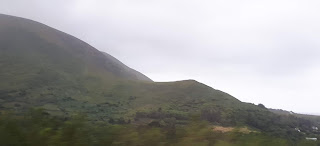Our
Saturday Aug 10 tour was the Ring of Kerry (An Mhór Chuaird), a loop
around the high hills of County Kerry. It was a somewhat shorter
touring day than most of the others, leaving Killarney at 8am and
returning close to 4pm. We
found out that busses are required to circle counterclockwise around
the loop, lest two of them meet going in opposite directions. The
roads in Ireland are very narrow by North American standards and
typically have no shoulders, with hedgerows of 3-4 metre high
“hedges” (more like trees!) growing right at the edge. At least
in most of the country; we later found that western Ireland has
drystone walls instead. Occasionally
there is a 1-lane bridge. Even if driving weren’t on the unfamiliar
left, I don’t think I could manage.
The tour seems to believe most people need “retail therapy” every day, so our first stop was Moriarty’s Gift Shop outside Killarney. They sell Irish crafts, in a variety of price ranges: hats, jackets, shirts, ... I took a look at the jewellery first, our guide having described their gold Skellig Michael pendants.
At
2000 euros, it was quite a bit out of my price range, but it was
beautiful.
The
reason for my interest was Skellig
Michael itself. It was a remote Christian monastery about 12
kilometres
out into the Atlantic to the west of Kerry. It was founded, according
to our guide, around 500 AD – but the Wikipedia article doubts
this. It remained continuously occupied until the early 13th century.
Over
what must have been hundreds of years the monks built a series of
steps up the steep rocks, over 600 over them, leading to a small
collection of igloo-like rock dwellings. The island recently became
more famous because it was used as the site of the Jedi ruins at the
end of Star Wars VII and much of Star Wars VIII.
We
passed several pieces of interesting Irish culture on the way. Here
is an ogham stone – one of the earliest forms of writing in Europe.
There
are “tidy village competitions” every year; citizens and city
councils go to a lot of effort to keep their towns clean.
The
town of Cill Orglain has a “Puck
goat fair” every year at this time. It celebrates a legend that
when Oliver Cromwell invaded, a goat came running down the main
street, which alerted the villagers of his arrival so they could
escape to the countryside and avoid the typical Commonwealth
slaughter of the native population. So each year they raise a 30’
high pedestal, put a local goat on it, and raise a toast to Puck.
Every
so often you’ll come across a tree left alone in the middle of an
otherwise actively-used field. They’re called “fairy trees”
from the belief in the mischievous and occasionally malign Fair Folk.
The claim is that animals won’t go near one, and cutting one down
is very bad luck. I regret how blurry this photograph is; it’s
mainly here to serve as a very rough indication of what a field with
one looks like.
There
are also fairy forts.
We
stopped at a Skellig Michael visitor’s centre on Valentia (the
island where the first transatlantic cable started) for lunch, and
watched an audio-visual about the island’s history. Taking a trip
to the island itself is a full day’s journey, involving taking an
hour’s ride in a small boat out into the potentially stormy
Atlantic, plus climbing those 600-odd steep steps (very slippery when
wet), with sheer drops, no handrails, occasional very narrow
passages, and six hours with no bathrooms. I’m sure that on my best
day I couldn’t manage it, given both the physical exertion and the
acrophobia triggers.
We caught a glimpse of the island, far off in the mists, behind a headland while driving away on the bus. It is the slightly darker lump just above the strip of coastline.
I
took a lot of countryside photographs, some from the bus, some on
foot.
The
region is quite hilly – or perhaps small-mountainy.
Some
hills are naturally terraced; this one is on the edge of Dingle Bay.
Others
are very rocky.
A
peat bog. Some people apparently still burn peat for heating and
electricity. There was a reconstructed peat bog village at one of our
rest stops, but I didn’t pay to go in.
A fair part of the ring is coastal.
As
we neared Killarney we entered the National Park, which includes
Muckross House (Teach Mhucrois) where Queen Victoria stayed. And it
was in the park that our guide explained about busses going
counterclockwise to avoid each other “but sometimes you’ll get a
camper coming the other way.” And so we did, about ten minutes
later, and at about the worst possible place, where the camper had
only a couple of feet of clearance at the start of the encounter
(barely enough for the passenger to get out and guide the driver),
and less clearance as it progressed.
We
returned to our hotel in Killarney and had the evening to ourselves;
there were plenty of restaurants nearby. I wrote the blog entry I
posted yesterday, and went to bed early. I usually sleep poorly the
first night in a new place – which makes a bus tour especially
difficult – but this was the second night, and I slept fairly well.













No comments:
Post a Comment